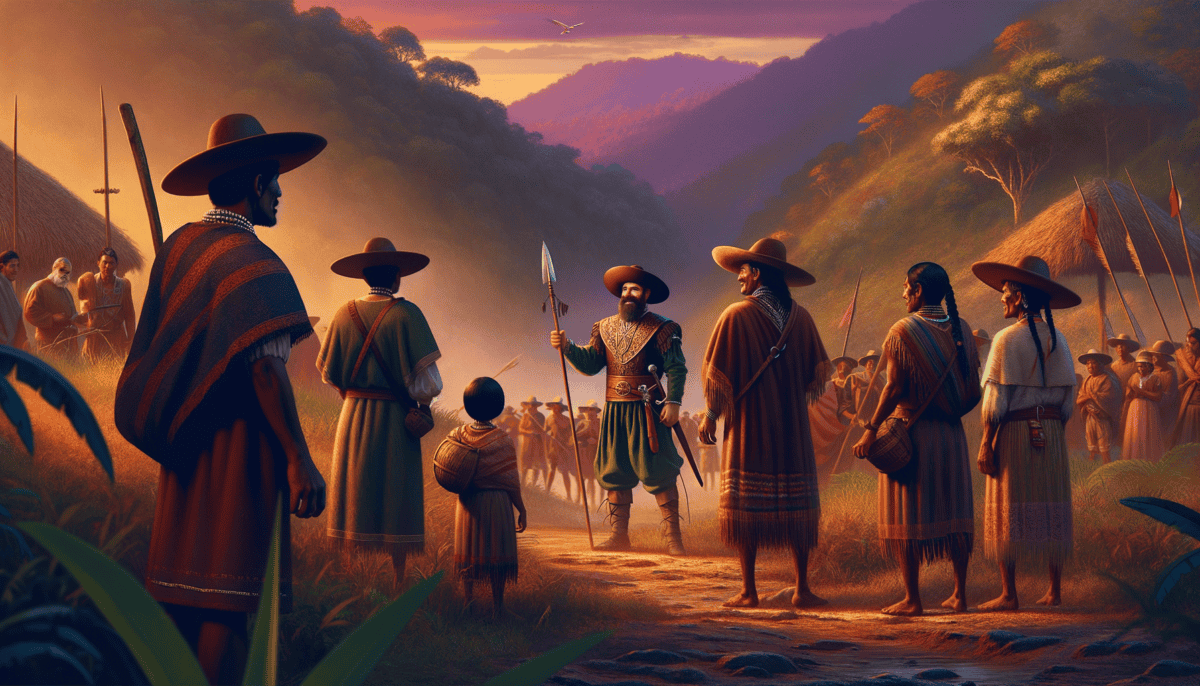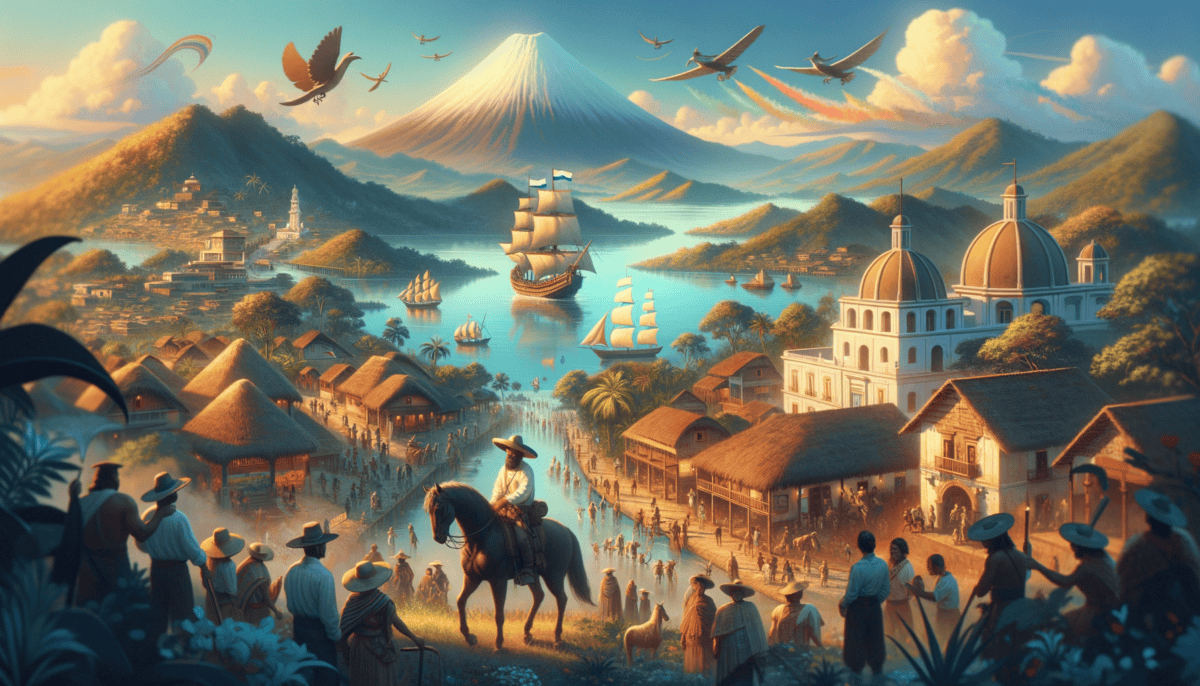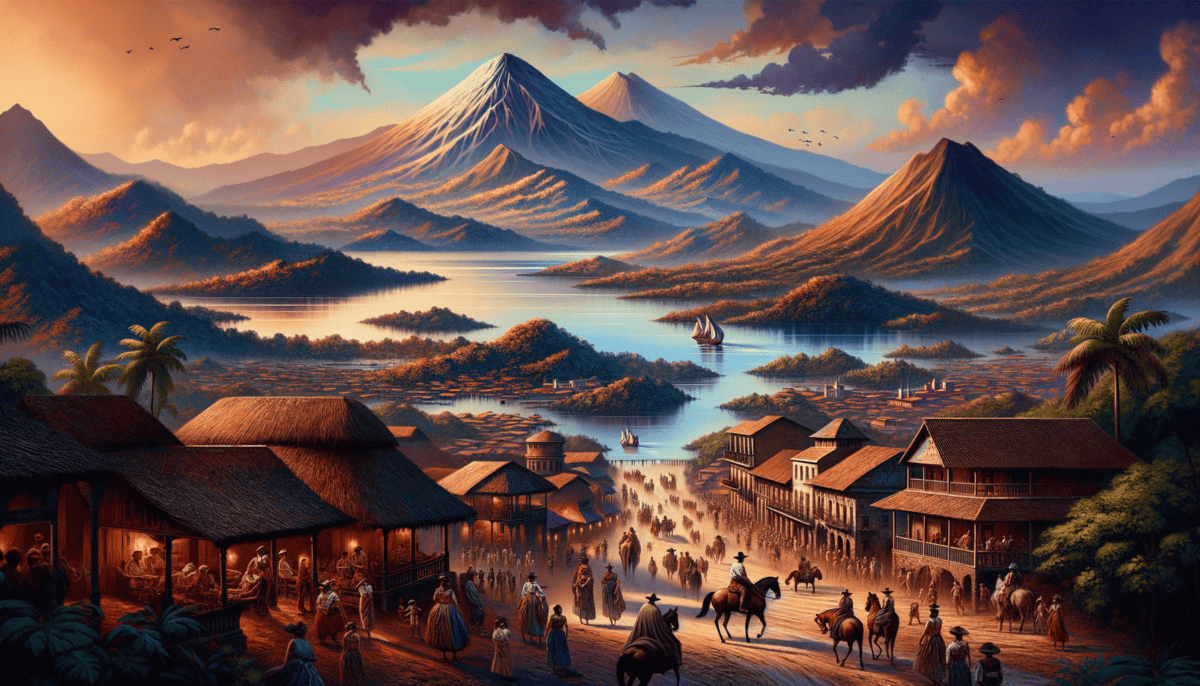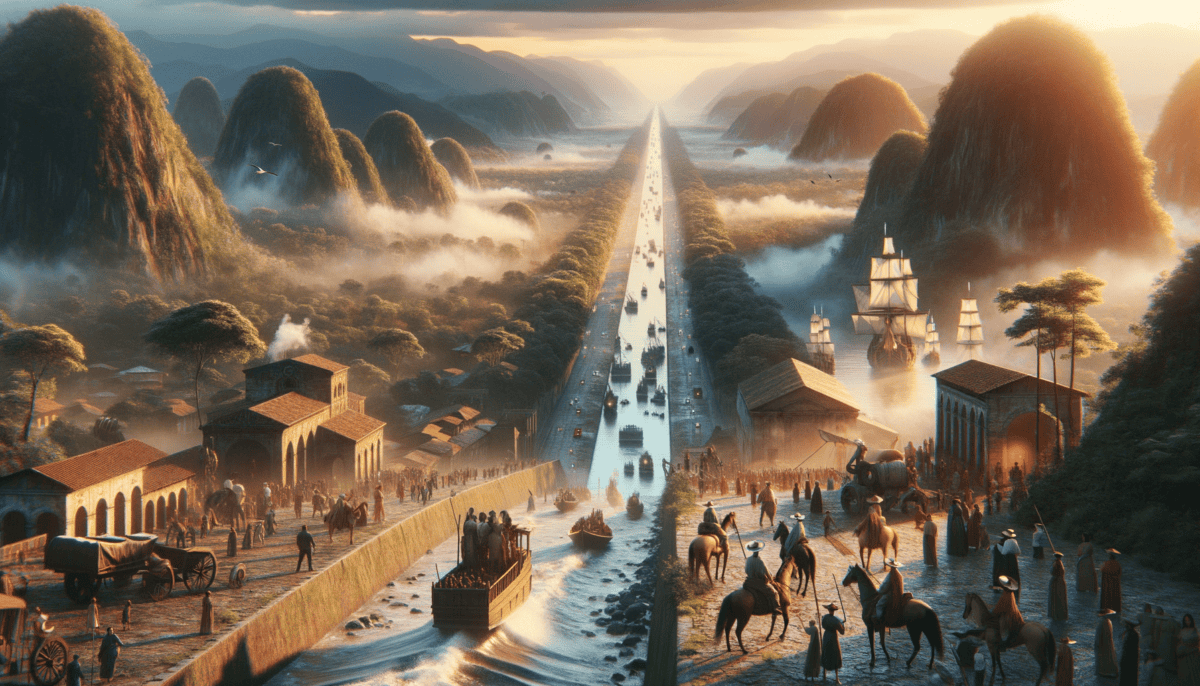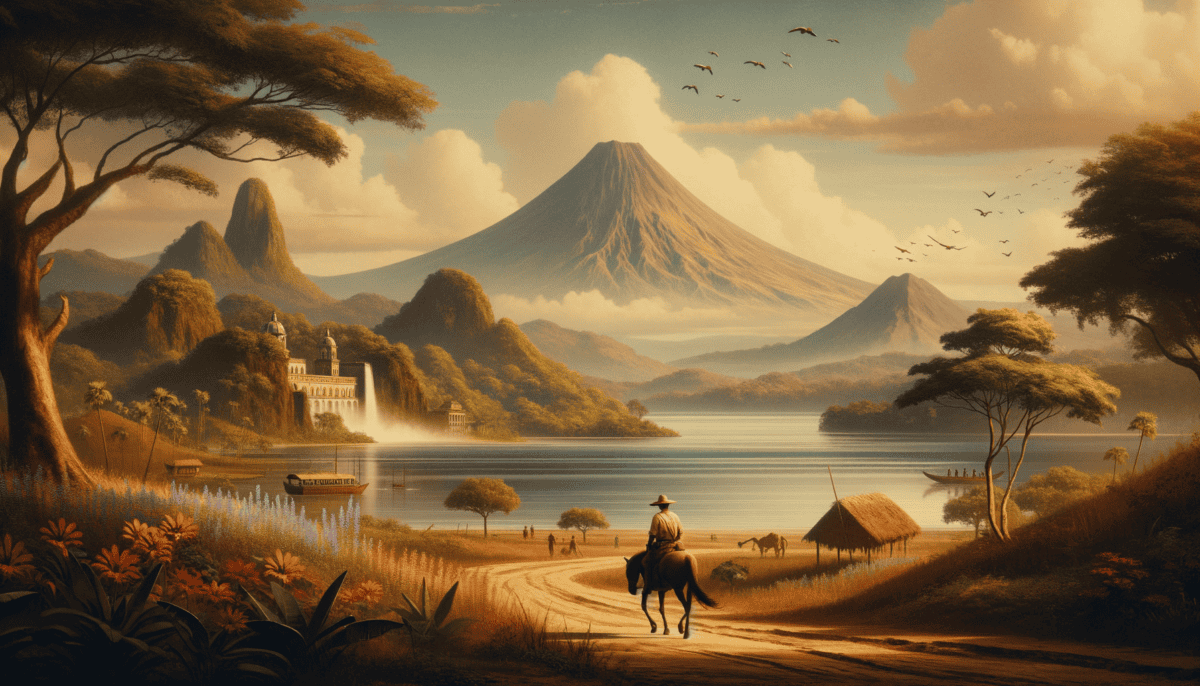The Ancient Guardians
Long ago, in a beautiful land between two big seas, lived special people called the Nicarao and Chorotega. They made their home in a place we now call Nicaragua.
"Look at the sleeping giants!" young Maya would say to her brother Luis, pointing at the tall volcanoes that touched the sky. Their grandmother smiled, remembering how her own grandmother had told her stories about these ancient mountains.
The land was magical. It had:
• Two huge lakes that sparkled like mirrors
• Tall volcanoes that watched over the people
• Green forests full of colorful birds
• Rich soil that grew lots of food
• Beautiful beaches with soft sand
Maya and Luis lived in a village near Lake Cocibolca, the biggest lake in all of Central America. Every morning, they would help their family grow corn, beans, and cacao. The sweet smell of chocolate filled the air as their mother ground cacao beans.
"Why do the volcanoes smoke sometimes?" Luis asked one day.
Their grandmother sat them down under a ceiba tree. Its branches spread wide like a giant umbrella. "The volcanoes are our guardians," she explained. "They remind us that Mother Earth is alive and powerful."
“Our people have lived here for thousands of years. We know every plant, every animal, and every season. The land is our teacher.”
Life was different back then. People lived in round houses made of wood and palm leaves. They didn't have phones or cars. Instead, they had something special – they understood how to live with nature.
The Nicarao were excellent farmers. They knew when to plant by watching the stars. The Chorotega made beautiful pottery with colors from special clay. Both groups loved to tell stories and dance during festivals.
In their village, everyone had a job:
- Some people were farmers
- Others made pottery and tools
- Some were hunters and fishers
- Wise elders taught the children
- Leaders helped make decisions
"But grandmother," Maya asked, "how did our ancestors know so much?"
The old woman touched the earth gently. "They listened," she said. "They listened to the wind in the trees, the songs of birds, and the rumble of volcanoes. They passed this wisdom down to their children, just as I'm passing it to you."
The sun began to set behind the volcanoes, painting the sky orange and purple. Life was peaceful for the ancient people of Nicaragua. They didn't know that soon, strange ships would appear on the horizon, bringing big changes to their world.
As night fell, grandmother looked at the stars. "Remember, children," she whispered, "the spirit of our ancestors lives in these mountains, these lakes, and in your hearts. Never forget their wisdom."
Maya and Luis nodded sleepily, watching the fireflies dance in the darkness. The volcanoes stood silent against the starry sky, just as they had for thousands of years, guarding the secrets and stories of Nicaragua's first people.
Conquest and Collision
The morning sun rose over Nicaragua differently in 1522. Strange ships appeared on the horizon, their white sails catching the wind. These were Spanish ships, and they would change everything.
“What are those floating houses?” young Náhuatl asked his father, pointing at the ships approaching their shore.
The village buzzed with worry. No one had ever seen anything like these huge boats or the men who rode them. The Spanish conquistadors, led by Gil González Dávila, stepped onto Nicaragua’s sandy beaches wearing shiny metal armor that gleamed in the sun. ⚔️
“They look like walking mirrors,” whispered the children, hiding behind their parents.
The first meetings between the Spanish and the native people were filled with confusion. Neither group could understand the other’s words. The Spanish spoke loudly in their language, while the Nicarao and Chorotega tried to use hand signals.
Chief Nicarao, a wise leader, tried to keep peace. He welcomed the strangers with gifts of gold and colorful feathers. But the Spanish wanted more. Much more.
Big Changes Come to Nicaragua:
• They built different houses with stone walls
• New foods like wheat bread came to the land
• Spanish became the main language
• Churches replaced many old temples
Life changed quickly for the native people. Many got sick from new diseases the Spanish brought. Others had to leave their homes and work for the Spanish. Some brave warriors tried to fight back, but the Spanish had stronger weapons.
“Remember our stories,” grandparents told their grandchildren at night. “Keep them safe in your heart.”
But not everything was sad. Over time, something new and special happened. The Spanish and native people started having families together. Their children learned both ways of life. They spoke Spanish but kept many old traditions.
A New Nicaragua Takes Shape
María, a little girl born years later, showed how things had changed. Her father was Spanish, and her mother was Nicarao. She loved eating both tortillas and Spanish bread. She spoke Spanish but also knew the old songs of her mother’s people.
“Tell me about the old days,” María would ask her mother.
“Our people were strong,” her mother would say, “and that strength lives in you. We may speak differently now, but our hearts still beat with the rhythm of these ancient lands.”
The volcanoes watched silently as Nicaragua changed. In villages and new cities, people learned to live new lives. They mixed old ways with new ones. They built churches but still told stories about the ancient spirits of the lakes and mountains.
As the sun set each day, it shone on a different Nicaragua than before. The land was the same, but its people were becoming something new – not just Spanish, not just native, but Nicaraguan.
The stars still sparkled over Lake Cocibolca, and the volcanoes still guarded the land. And in homes across Nicaragua, children like María dreamed of tomorrow while remembering yesterday.
Life Under Spanish Rule
The sun rose over Granada, Nicaragua’s newest Spanish city. It was 1524, and life was very different now. The streets were filled with new sounds, smells, and sights.
Young Isabella walked through the plaza with her grandmother, Elena. The cobblestone streets felt strange under their feet. Around them, Spanish soldiers marched, merchants sold goods, and church bells rang.
“Abuela, why do we have to live in this new city?” Isabella asked, missing their old village.
Elena squeezed her granddaughter’s hand. “Times change, mi amor. But watch – we are making something new here.”
• Market days filled with trading
• Farmers growing new crops
• Ships coming and going from Spain
• People learning new jobs
• Churches teaching new beliefs
The Spanish built big houses called haciendas where they grew cacao and indigo. Many native people had to work on these farms. It was hard work under the hot sun.
“Look there!” Isabella pointed at the harbor. Pirates were a big problem in those days. Their ships would attack the Spanish boats carrying gold and silver back to Spain. ⛵
The city walls had to be strong to keep pirates away. Sometimes they attacked anyway, looking for treasure.
But life wasn’t all about work and worry. In the evenings, people gathered to tell stories and sing songs. Children played games in the streets while their parents talked and laughed together.
“¡Baila conmigo!” (Dance with me!) A boy called out to Isabella, as musicians played both Spanish guitars and native drums.
A Growing Town
Granada grew bigger every year. New buildings went up, and more ships came to trade. The Spanish built schools where children learned to read and write in Spanish. But at home, many families still spoke their native languages.
“Why do some people have big houses while others have small ones?” Isabella asked her grandmother one day.
Elena sighed. The Spanish had made new rules about who was important based on where people came from. Some people got special treatment while others didn’t.
Changes Come Fast
More changes came when English and French pirates started causing trouble. They would hide in the small islands of Lake Nicaragua. The Spanish built strong walls and towers to protect the city.
One day, Isabella saw smoke rising from far away. “Pirates!” someone shouted. Everyone ran inside while soldiers rushed to defend the city.
But Granada stood strong. The pirates couldn’t take the city. After that, more soldiers came to protect Nicaragua’s towns and trade routes.
As Isabella grew older, she noticed more people speaking up against the Spanish rules. They wanted more freedom to make their own choices. Even some Spanish families born in Nicaragua started thinking differently from those in Spain.
“Things can’t stay the same forever,” Elena told Isabella one evening, looking out over the lake. “Just like the waves change the shore, time changes all things.”
The sun set over Lake Nicaragua, painting the sky orange and purple. In homes across Granada, families ate dinner together, mixing Spanish and native foods. Children fell asleep to stories about brave pirates, clever traders, and the old days before the Spanish came.
Tomorrow would bring new changes, but the spirit of Nicaragua’s people remained strong, like the volcanoes watching over their land.
Dreams of Freedom
The morning sun peeked through the windows of León’s central plaza in 1811. María watched as people gathered in small groups, whispering about independence.
“Papa, why are people so excited today?” María asked her father, José, a local merchant.
José looked around carefully before answering. “Big changes are coming, mi pequeña. People want Nicaragua to be free.”
• Miguel Larreynaga – A wise teacher
• José Antonio Velásquez – A brave fighter
• Manuel Antonio de la Cerda – A strong leader
• Cleto Ordóñez – A people’s hero
• Josefa Chamorro – A brave woman leader
In the streets, two groups fought about Nicaragua’s future. The Liberals wanted big changes and freedom from Spain. The Conservatives wanted to keep things the same.
“Listen to the wind of change,” María’s grandmother would say. “It brings new ideas from far away.”
News traveled slowly back then, but exciting stories reached Nicaragua. Other places in Latin America were fighting for freedom. Heroes like Simón Bolívar were winning battles against Spain.
The First Steps
One day, María saw a crowd gathering near the church. A man named Miguel Larreynaga was speaking about freedom. His words made people’s hearts beat faster with hope.
“We deserve to choose our own path!” Larreynaga called out. The crowd cheered.
But change wasn’t easy. Some people were scared of what might happen. Others worried about fighting. The Spanish soldiers still walked the streets with their shiny swords.
José taught María about the new ideas spreading through Nicaragua:
“We want to make our own choices.”
“Everyone should have a voice.”
“Our land should belong to us.”
Growing Dreams
María watched as more people joined the independence movement. They met in secret, sharing books and papers about freedom. Women like Josefa Chamorro helped by sending messages and hiding important papers.
The Spanish tried to stop these meetings, but they couldn’t stop people’s dreams of freedom. Every day, more people talked about independence.
“What will happen when we’re free?” María asked her father one evening.
José smiled. “We’ll build our own country, mi amor. We’ll make our own laws and choose our own leaders.”
But there were hard times too. Sometimes people fought in the streets. Families disagreed about what was best for Nicaragua. The Spanish soldiers arrested anyone who talked about freedom.
A New Dawn
Then one special day arrived. Riders came from Guatemala with amazing news: Central America was declaring independence from Spain!
People ran into the streets celebrating. Church bells rang. Everyone hugged and cried happy tears. But this was just the beginning of Nicaragua’s journey.
María held her father’s hand as they watched the celebrations. “Are we really free now?” she asked.
José looked thoughtful. “We’re taking our first steps, pequeña. Building a free country takes time and hard work. But now we can dream bigger than ever before.”
The sun set over León that evening, painting the sky in the blue and white colors that would one day become Nicaragua’s flag. In homes across the city, people stayed up late talking about their hopes for the future.
A warm breeze carried the smell of freedom through the streets. Nicaragua was changing, and its people were ready to write their own story. ⭐
Revolution’s Fierce Heart
The sun rose over Managua in 1927, casting long shadows across the city streets. Little Juan watched from his window as soldiers marched past. His mother pulled him away from the sight.
“Mama, why are there so many soldiers?” Juan whispered.
“Those are Somoza’s men, mi hijo,” she replied softly. “But there are others who fight for the people too.”
• Augusto Sandino – The brave leader
• Carlos Fonseca – The teacher of revolution
• Daniel Ortega – The young fighter
• Tomás Borge – The strong voice
• Dora María Téllez – The fearless woman
In the mountains, a man named Augusto Sandino led brave fighters against the powerful Somoza family. They wanted freedom for all Nicaraguans. ️
Juan’s grandmother told stories about Sandino: “He wore a big hat and fought like a tiger for our people’s rights.”
The People’s Hero
One evening, Juan heard his parents talking in hushed voices about Sandino’s army. They were called the “pequeños ejercitos locos” – the crazy little army. But they weren’t really crazy – they were brave!
“Sandino fights for the poor people,” Juan’s father said. “He wants everyone to have enough food and land.”
The Somoza family was very rich and powerful. They controlled everything in Nicaragua. Many people were very poor and hungry. It wasn’t fair.
The Rise of Hope
Years passed, and Juan grew older. He learned about a new group called the Sandinistas. They were named after Sandino and carried on his dream of freedom.
Young people joined the Sandinistas. They taught others to read and write. They helped farmers grow food. They wanted to make Nicaragua better for everyone.
Carlos Fonseca taught people about Sandino’s ideas.
Students shared books about freedom.
Workers joined together to fight for their rights.
The Big Change
The fight was hard and long. Many brave people gave their lives for freedom. But the people didn’t give up. In 1979, something amazing happened – the Somoza family lost power!
“What happens now?” Juan asked his father, watching celebrations in the streets.
“Now we build the Nicaragua that Sandino dreamed about,” his father answered with tears in his eyes.
New Challenges
The Sandinistas tried to make things better. They built schools and hospitals. They gave land to poor farmers. But there were still problems. Some people didn’t like the changes.
The United States worried about Nicaragua. They helped people who fought against the Sandinistas. These fighters were called the Contras.
Nicaragua became part of a bigger fight called the Cold War. The Soviet Union helped the Sandinistas, while the United States helped the Contras. It was a hard time for everyone.
The Spirit Lives On
Through all the fighting, the spirit of Sandino stayed alive. His dream of a free and fair Nicaragua never died. People remembered his words about justice and hope. ⭐
Today, Nicaragua still faces challenges. But the story of Sandino and the revolution teaches us something important: regular people can change the world when they work together.
As the sun set over Managua, Juan looked at his own children playing in the yard. The spirit of revolution lived in their free laughter, in their dreams, and in their future.
Dreams of Tomorrow
The morning sun sparkles on Lake Nicaragua as Maria walks to her new school. The year is 2023, and Nicaragua is different from the country her grandparents knew.
“Abuela, tell me again about the revolution,” Maria asks during their afternoon visits.
Her grandmother smiles, touching the old photograph on the wall. “Those were different times, mi amor. We fought for the dreams you live today.”
Building Better Days
Nicaragua faces new challenges now. The country is working hard to grow and change. Many people are learning new skills and starting businesses.
Young farmers growing organic coffee
Teachers bringing computers to schools
Artists painting colorful murals
Scientists protecting the rainforests
Community leaders helping their neighbors
In the countryside, farmers like Maria’s uncle Pedro use smart ways to grow food. They protect the soil and save water.
“We must take care of our land,” Pedro says. “It’s a gift from our ancestors.”
Protecting Nature’s Gifts
Nicaragua’s beautiful lakes and volcanoes need protection. People work together to keep them clean and safe. They plant trees and pick up trash.
Children learn about saving animals and plants.
Communities clean beaches and rivers.
Scientists study ways to stop pollution.
Learning for Tomorrow
More children go to school now than ever before. They learn about computers and science. They dream big dreams about their future.
“I want to be a doctor,” Maria tells her teacher. “I want to help people in my village.”
Her teacher beams with pride. “You can be anything you want, Maria. That’s what the revolution was for.”
Working Together
Communities help each other grow stronger. People share what they have and work together to solve problems. ❤️
“Remember,” Abuela says, “the spirit of Nicaragua is like our volcanoes – powerful and alive!”
Looking Forward
Young people like Maria carry new hopes for Nicaragua. They use computers and phones to connect with the world. They share ideas and make new friends.
Some problems still need fixing. Not everyone has enough food or money. But people work hard and don’t give up.
The sun sets over Lake Nicaragua, painting the sky in beautiful colors. Maria stands with her grandmother, watching boats sail on the water.
“What do you see in Nicaragua’s future?” Maria asks.
Her grandmother hugs her tight. “I see you, mi amor. You and all the children who will make our country even better.”
The story of Nicaragua continues. It’s a story of brave people, beautiful land, and big dreams. It’s a story that belongs to everyone who loves this special place between two oceans, where volcanoes touch the sky and hope grows like corn in the fields. ⭐


